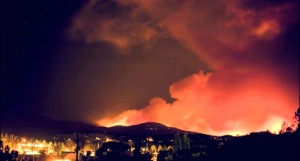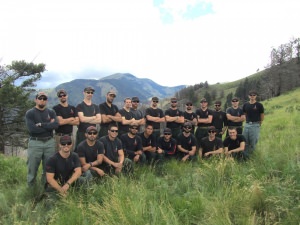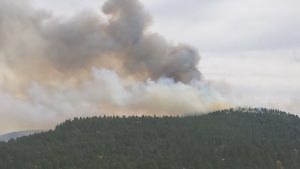
Smokey Bear Hotshots: Fire Sentinels Standing Duty
Their policies, objectives, and standards are well-defined and therefore clearly understood by all in the group. The skills they maintain are periodically tested to the maximum as they potentially place their lives on the fire line. But these Smokey Bear Hotshots, battle-proven fighters, fully realize they are there to save lives and property, first and foremost.
Much of the time they operate in hazardous situations – or at the very least – in rough terrain. For the most part, they must pack equipment and the necessary tools of the trade into danger zones in 45-pound packs. They are prepared, in exceptional physical shape, self-sufficient collectively, and have a proud heritage.
By now you might believe a unit of U.S. Army Rangers is being discussed. But, in this case, you would be wrong. No, it’s the elite firefighting Hotshots in the U.S. that are being depicted.
The Smokey Bear Hotshots of Ruidoso follow the same guidelines as other such commensurate crews in the U.S. To date, there are 115 Hotshot factions in this country (of varying standards). The top echelon personnel here consists of Superintendent Beau Jarvis, Assistant Superintendent/Captain Errick Kimbrell, three squad leaders, and two senior firefighters (all permanent). Most Hotshots (15 here) are seasonal employees in that they are usually hired only part of the year (March – September). But this shows a high level of commitment to firefighting for some.

Additionally, the Hotshots of this scenic mountain village have to conform to definitive “ground rules” such as: work and train together a minimum of 40 hours per week during availability period; have permanently assigned leadership; be able to mobilize within two hours when available; possess hand tools (including chain saws) and a myriad of other qualifications and obligations.
Before the advent of the Hotshots, Forrest Rangers and inmates fought fires across the width and breadth of the country.
In 1946, the Del Rosa (Region 5, Calif.) Hotshots became the first chapter of this now venerated, collective organization throughout the U.S. It was largely comprised of veterans coming out of WW II. That’s why, today, Hotshots have an affinity for hiring vets. Currently, the national inter-agency headquarters is in Boise.
The Smokey Bear Hotshots of Ruidoso has been in existence for decades, is now part of a national resource and therefore can go anywhere in America (and Canada, as it has) if so ordered. Regional and national work are part of the charge. The group in this mountain vista community usually work a fire for 14 days. An additional three days are allotted for travel.
The Cree Fire of 2000 (May 16), a nearly 9,000-acre blaze, was allegedly started by four young people without criminal intent. The Smokey Bear fire group was in Arizona at another fire and hurriedly traveled back.
When the White Fire hit in early April of 2011 our local Hotshots were in Albuquerque and hastily transported themselves back here to help fight that inferno, which nearly destroyed 5,000 acres.
The monstrous Little Bear Fire of early June, 2012, burned approximately 35,399 acres before it was arrested. The Ruidoso Hotshots were in Tucson when that catastrophe struck. They started driving here on June 8, arrived the following day and worked until the 27th (19 days). That calamity lasted a total of two months.

The Moon Mountain Fire afflicted this area in late March of 2016 and consumed about 125 acres. Guess who was there?
In late February of this year, the Hotshots were called out to help quell a 550-acre blaze. It was put out on Feb. 26.
“Our mission is vegetation, not specifically structure fires,” Superintendent Jarvis said. Asked why he is gratified being a Smokey Bear Hotshot he exclaimed, “I enjoy being outside in the woods. I like fighting fires, as most do. It’s rewarding saving property and lives. People are appreciative.”
Jarvis goes on to explain the attack phase of firefighting. “We throw everything we have at a fire,” he said. “We can’t stop 100 percent of them. We do what we can.”
Some of the work is done with bulldozers, graders, etc., however, remote terrain requires the expertise of Hotshots, hand tools, chain saws, hand ignition devices, and people to carry these implements into the fire zones. This obviously calls for a higher fitness level training qualification experience, Type 1, than say a Type 2 category.
When asked if he would become a Hotshot again, 13-year veteran, Kimbrell, replied, “I would easily do it all over.”
American citizens are most fortunate to have such dedicated, gallant fighters amongst them. Like most U.S. Armed Services veterans, however, they would most likely be disinclined to receive notoriety.
—Michael Curran





